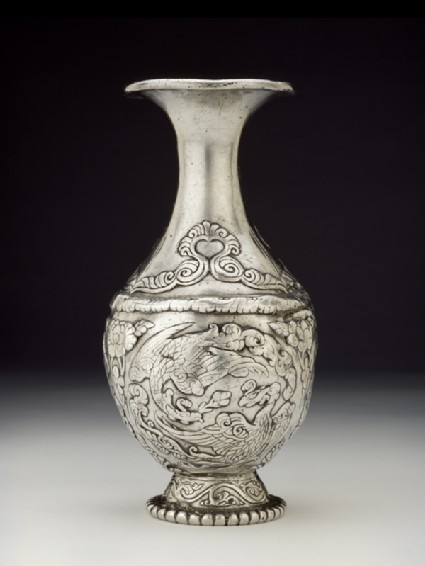Browse: 22 objects
- Reference URL
Actions
Silver vase with pairs of phoenixes
-
Details
- Associated place
- Date
- 8th - 9th century AD (AD 701 - 900)
- Material and technique
- silver, lost-wax cast, with repoussé decoration
- Dimensions
-
16.8 cm (height)
8.4 cm (diameter)
454.7 g (weight)
- Material index
- Technique index
-
formed › cast › lost wax cast,
- Object type index
- No. of items
- 1
- Credit line
- Purchased, 1999.
- Accession no.
- EA1999.98
-
Further reading
Heller, Amy, Early Himalayan Art (Oxford: Ashmolean Museum, 2008), no. 15 on p. 74, p. 20, illus. p. 75
Glossary
repoussé
-
repoussé
Decoration worked on the underside of the metal to produce a raised decorative effect.
Location
Objects are sometimes moved to a different location. Our object location data is usually updated on a monthly basis. Contact the Jameel Study Centre if you are planning to visit the museum to see a particular object on display, or would like to arrange an appointment to see an object in our reserve collections.
Publications online
-

Early Himalayan Art
This silver vase [1] corresponds to a type of flask recognizable from two parcel gilt silver vases datable from their inscriptions to the Tibetan dynastic period [2]. Although no inscription or trace of former lettering is now visible, the vase’s shape, design motifs, technique, and weight all suggest a Tibetan provenance of the eighth to ninth century. Its ovoid body has three pairs of phoenixes circling each other in flight. The arc formed by their long tail-feathers creates a roundel within which the female holds a leaf sprig in front of her beak. In typical Tang design, the bird would clasp the stem in her slightly open beak and present it to the male, but here, in a slight modification, the beaks of both birds remain closed. Their heads are in profile, and the male has a curved parrot-like beak and round eyes, while the female’s head is elongated, with almond-shaped eye and a more rounded beak. The crest feathers and body plumage appear identical in both sexes, which corresponds also with the phoenix pairs seen in Tang silver and textile motifs [3], as well as the gold reliquary box consecrated in 874 ad, excavated from the Famen temple [4]. Between the pairs of birds, peonies in full bloom decorate the upper section of the vase. A lotus rhizome encircles the vase’s foot.
This vase shape appears to have been introduced into China from the West. In Central Asia, Sasanian vases of this form persist through the seventh to the eighth century and share the chain of linked petals separating the main design from the motifs on the vase’s neck [5]. In the upper section, a chain of linked petals in relief is again used to define a recessed design in the shape of a heart [6]. This was a frequent secondary motif in Sasanian design. Following the extension of their empire along the Silk Route into Central Asia, and particularly during their occupation of Dunhuang in the eighth to ninth century, the Tibetans were inspired by designs of both Sasanian and Chinese prototypes for the creation of their silverwork at this time. In terms of technique, the vase was made in three parts, the neck, body, and base each being separately cast using the lost-wax technique. It was then assembled and chased, with the beaded edge soldered on the lower rim. As this shape of vase is still made in Nepal today, it is quite possible that the Tibetans were influenced by Newar artisans working in Tibet in the seventh and eighth centuries, and combined Nepalese casting techniques with an imagery that was entirely foreign to Nepal. This harmonious blending of different stylistic grammars and metalwork techniques appears to be the hallmark of Tibetan taste during this period.
[Footnotes:]
1 Published in Heller, Tibetan Art, p. 8, fig. 4; its weight is 454.7 g.
2 Carter, ‘Three Silver Vessels from Tibet’s Earliest Historical Era: A Preliminary Study’, fig. 1: Tibetan vase in the Cleveland Museum of Art, mid- to late seventh or eighth century, partially gilt silver, h. 22.9 cm, with a now illegible Tibetan inscription on the upper rim; and Heller, ‘Archeological Artefacts from the Tibetan Empire in Central Asia’, figs. 16a–d: Tibetan vase in the Pritzker Collection, Chicago, eighth to ninth century, parcel gilt silver, h. 1 9 cm, weight 4 3 7 g., with a Tibetan inscription on the base.
3 Uldry, Chinesische Gold und Silber, pls. 149, 187; and Rawson, The Ornament on Chinese Silver of the Tang Dynasty (AD 618–906).
4 Han Wei and Deydier, Ancient Chinese Gold, pl. 513.
5 Van den Berghe and Overlaet, Splendeurs des Sassanides, pl. 93.
6 In the Cleveland Museum vase the recessed heart design is used to define the separation of the neck of the vase.
Galleries
© 2013 University of Oxford - Ashmolean Museum





